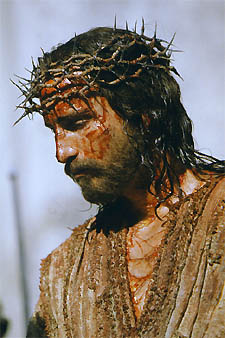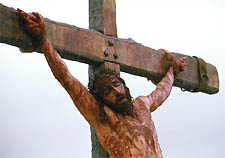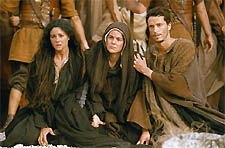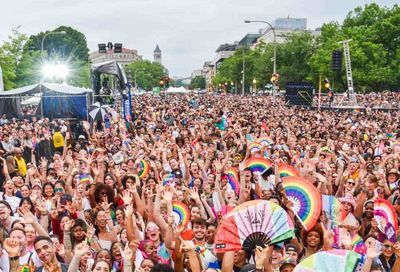Bloody Pulpit
Mel Gibson's obsessively savage ''The Passion of The Christ''
Mel Gibson’s The Passion of the Christ can be summed up in a single word: obsessive.
The movie, which concentrates on the final twelve hours of Jesus Christ’s life, is obsessively, unrelentingly violent in its depiction of the scourging of the Jewish prophet who would become the centerpiece of Christianity. Gibson is so fixated on the torture and torment of Jesus Christ that nothing else seems to matter, not the teachings of the man, not his personal spiritual quest, not the followers who surrounded him.
 |
Although it is interpretive in its presentation of the facts, The Passion of the Christ presents itself with the confidence of pure, unadulterated dogma. It wants to be the last word on the subject without offering up a theological exploration (as did Martin Scorsese with his dynamic and far superior The Last Temptation of Christ) or a solid dramatic construct. It is, essentially, a two-hour climax, a blood-drenched chamber of horrors, and more often than not it repels us, keeping us at a wary distance rather that drawing us in closer to the subject at hand.
Gibson, a conservative Catholic and a traditionalist, fully intends provoke this kind of response, to strike a chord of gut-instinct emotion. But the chord struck is likely to resonate only with the most devout believers. And since I am not among those believers, The Passion of the Christ was very clearly not meant for me. It’s not an instructive or illuminating experience, one that shows why Christ’s suffering was so important to the eventual construct of Christianity, but a visceral and vicious one. Basically, it’s Mel Gibson on a bloody pulpit preaching to the converted.
 |
Taken from a purely cinematic standpoint, The Passion of the Christ is a visually impressive piece, shot by the outstanding cinematographer Caleb Deschanel, whose lush work on 1979’s The Black Stallion still remains one of the most resplendent examples of modern cinematography. It is also, on occasion, artistically impressive, particularly in some of Gibson’s shot selections, such as a God’s eye view of Jesus’ death on the cross, which culminates in a single raindrop — God’s tear — falling to Earth.
But the movie lacks dramatic weight. It feels incomplete, as though we’ve walked into the last two hours of a six-hour epic. By relegating Jesus Christ’s backstory to a few instantly recognizable soundbites, scattered throughout in a smattering of brief flashbacks, Gibson does his subject an injustice.
 |
Plucked from various passages of the gospels of Matthew, Mark, Luke and John, most of The Passion of the Christ is taken up by Jesus’ capture by the Jewish high priests, his delivery to the Romans, his subsequent inhuman scourging, and his long, arduous cross-bearing walk from Jerusalem to Golgotha, where he is inevitably crucified.
That cross-bearing sequence is the longest stretch of film — perhaps nearing forty minutes — and it feels interminable. We’re relieved by the time Jesus has reached Golgotha (though relief should be the last thing we’re feeling at that moment). Gibson wants his audience to experience every little last bit of Jesus’ suffering — to become witnesses to his persecution. But it’s almost too hard to watch without covering our eyes. The movie is as horrifically violent as any in recent memory — and while the violence purports to serve a greater purpose, it feels mostly gratuitous and sadistic.
 |
The most effective moments are those in which the violence against Jesus are implied — for instance, a low-perspective shot in which we see only Jesus’ quaking hands as the Roman soldiers behind him lash away. The least impactful are those in which we visibly see everything — the literal shredding of his flesh by razor-tipped floggers, for example. The bloodletting is overwhelming and mind-numbing. And yet, to be fair, it’s probably the most realistically-imagined depiction of Jesus Christ’s actual torment.
During the swirl of pre-release controversy, Gibson swore that his movie was not anti-Semitic. And I would agree — it’s not, at least not directly. The Passion of the Christ seems imbalanced when it comes to assigning blame. While the Roman soldiers are depicted as barbarous and sadistic, Pontius Pilate and his first general are seen as deeply concerned for the fate of Jesus, almost to the point of remorse.
 |
Meanwhile, the Jewish high priests are clearly framed as the heavies — even a continuously lurking, androgynous Satan comes off as less evil than the scowling high priest Caiphas. And a lynch mob scene in which the Israelites and an anger-crazed Caiphas call on a kowtow-primed Pilate to crucify Jesus still includes a guilt-absorbing line that has been used for centuries to foment anti-Semitic sentiments. Prior to release, Gibson promised concerned theological leaders — both Christian and Jewish — that he would cut the offending line. But he appears to have only removed the English subtitle. The line apparently is still spoken in Aramaic (the film’s dialogue is recited entirely in Aramaic and Latin), ready to be subtitled in other languages for the international editions of the film and to be possibly reincluded in the DVD.
The performances, with the exception of Hristo Shopov, who plays Pilate, and Maia Morgenstern, who plays Jesus’ mother Mary, lack genuine depth. King Herod is played by an uncredited actor with mincing, disheveled flamboyancy. The handsome Hristo Jivkov as John and the gorgeous Monica Bellucci as Mary Magdalene are merely used by Gibson as pretty adornments, something pleasing to look at occasionally, a stark contrast to the atrocities being committed against their beloved prophet.
|
James Caviezel, who plays Jesus, has the right look for the title role, but for much of the film is turned into a wailing, bleeding mass of extreme agony. Caviezel is pretty much portraying a whipping post, a receptacle for pain — and, according to Christian faith, for all of humankind’s sins.
There’s little nuance on hand in The Passion of the Christ — the movie attains its purpose through brute, barbaric force. Still, the important thing to remember is that despite its frequently grueling intensity, despite its attempt to convey some kind of cathartic religious message, The Passion of the Christ is not a historical — or for that matter theological — exploration. It is but a movie. And unlike other Biblical epics, which at least strive to be safe for family viewing, The Passion of the Christ may very well be traumatic to younger audience members. Its images of violence and savagery against one man will forever sear into young impressionable minds.
So, if Mel Gibson has accomplished anything , it’s that he’s given the normally pristine representation of Jesus Christ a bloody makeover. The glory of God just got a new image.
Support Metro Weekly’s Journalism
These are challenging times for news organizations. And yet it’s crucial we stay active and provide vital resources and information to both our local readers and the world. So won’t you please take a moment and consider supporting Metro Weekly with a membership? For as little as $5 a month, you can help ensure Metro Weekly magazine and MetroWeekly.com remain free, viable resources as we provide the best, most diverse, culturally-resonant LGBTQ coverage in both the D.C. region and around the world. Memberships come with exclusive perks and discounts, your own personal digital delivery of each week’s magazine (and an archive), access to our Member's Lounge when it launches this fall, and exclusive members-only items like Metro Weekly Membership Mugs and Tote Bags! Check out all our membership levels here and please join us today!





























